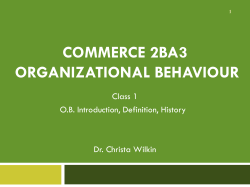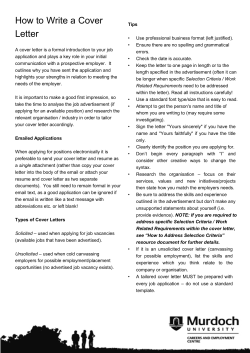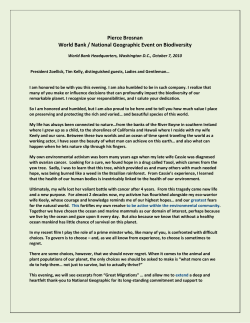
Recruitment practices and talent search- how to build human capital
Recruitment practices and talent search- how to build human capital - Atul Shirgaonkar, CEO, Insight Systems Inc., Pune All the clever thoughts have long since been thought, what matters now is to think them anew. --- Goethe The above topic is part of the main theme of the conclave „Employees first Customers next‟. This is not a catchy slogan but a practice used by many companies in the past. It was however practiced individually in terms of small packets and not as a comprehensive package. This really came to prominence during February 2005, when Vineet Nayar, CEO, HCL Technologies announced it as a radical new philosophy, “Employee First, Customer Second” (EFCS). Through this philosophy the aim was to create a unique employee organization, drive an inverted organizational structure, create transparency and accountability within the organization, and encourage a value driven culture. The five pillars of EFCS are Knowledge, Empowerment, Transformation, Recognition and Support. Human Capital Management ( HCM ) therefore becomes an inseparable part of this concept. Human capital can be defined as „The sum of a company's employees including their skills, competencies, talents, creativity and know-how. Within each employee is the knowledge the company seeks to utilize. Further, Human Capital Management can be defined as “an approach to people management that treats it as a high-level strategic issue and seeks systematically to analyze, measure and evaluate how people policies and practices create value”. The word „capital‟, analogous with finance, is used in terms of people being assets whose value can be enhanced through investment. The goal of Human Capital Management is not to create new lines on financial statements, organizational charts, flowcharts, processes, or scorecards. Effective Human Capital management develops “human” resources… creating effective links of talent and relationships to facilitate the accomplishment of the organization's mission. Similarly, there‟s a floor to cost reduction but no ceiling to value creation hence, human capital should be viewed as a value-producing asset instead of a cost to be minimized, reduced, or reined in. Since I am associated with the pharmaceutical, food and healthcare industry ( which in true sense deals with the physical enhancement and maintenance part of the human capital ! ) we as the above industry are focused on the systems and good practices. Any good system or practice builds / develops a model so that planning and execution go hand in hand. I would like to share a seven planet orbital model here of the human capital management system practiced by the great leader Mohammad Yunnus of the Grammen bank. The Human Capital Management System Model “There are no recipes or formulae, no checklists or advice that describe “reality”. There is only what we create through our engagement with others and with events.” (Margaret Wheatley, “Leadership and the New Science”) It goes without saying that human capital approaches should be designed, implemented, and assessed by how well they help any organisation achieve strategic results and pursue its vision and mission. This involves creating a clear picture of the future that „stimulates, excites and inspires. A vision is : • a picture of the future that we want • a point of strategic focus for the leadership of the organisation or team • something for everyone to work towards Any organization must identify those practices critical to success, and ensure a strong foundation. In addition, they should allocate the right resources to determine the design of HCM practices necessary to drive strategy. This will happen after a series of experiments, celebrating small successes and learning for improvements / new strategies from these experiments. Let us look at the individual planets of this orbital model. Planet 1 – HR Planning “People want to be part of something larger than themselves. They want to be part of something they’re really proud of, that they’ll fight for, sacrifice for , trust.” —Howard Schultz, Starbucks When HR planning is mentioned, it‟s over and above the numbers and figures. Create a realistic, strong job description. Get it endorsed by the team where the employee would be working. After taking care of the technical part, now focus on what are the other aspects needed from the employee that fits into the organisation bill. Have working salary plans, incentive structures, performance metrics and retention policies. Look at what is available and viable. Here is a decision to make in terms of brand inside vs. brand outside. Meaningful considerations would involve assessing the current source and inventory of top performers, making more of them available to the organisation, focussing and revisiting retention strategies and assessing financial consequences of HCM decisions on business. Attraction is part of retention, so this information also forms an important part of recruitment practices. Once on board, the all the efforts ultimately are directed towards a single aspect that when human assets walk out of the work place every night, it becomes the managements job is to ensure that they love coming back every morning. Planet 2 – Recruitment and Selection “Organizations need to get the right people on the bus and in the right seats to succeed.” “Good coaching, training, mentoring, etc., is not likely to make up for bad selection.” “Hire hard….Manage easy!” - Collins, J. (2001). Good to great. Journey to the second planet is a very critical aspect to the success endeavours of any organisation. These two terms though used interchangeably are different from each other in the fact that recruitmentit includes tracing, identifying, developing the sources of prospective employees and attracting them to apply for jobs in an organization. It‟s more of a discovery process facilitating the process of selection. Selection is the process of finding out the most suitable candidate to the job out of the candidates attracted. Recruitment is positive as it aims at increasing the number of applicants for a better selection ratio whereas selection rather is a method of deletion as it selects the suitable candidates and eliminates not „up to the mark/s‟. The function of recruitment therefore precedes the selection function. This involves lot of planning preparation and effort. Managers involved in recruiting and selection, almost 95% of them, indicated that hiring is number one or number two in their order of importance. Yet, they spend only 10% to 15% of their time on the preparations. As Vineet Nayar in his philosophy of EFCS advocates inverting the organizational pyramid ( turning conventional management upside down ) to convert the same into a star model, a similar effort is necessary for the recruitment pyramid which is depicted below : Typically the preparation process for recruitment and selection aligns with Steven Covey‟s second habit, begin with the end in mind. The homework might involve systematic steps towards effective selection, interview and assessment processes. Modern day advertising makes use of all the resources at hand, the print and media for instance, referral programmes, kiosks, representations at fairs/conferences/congresses. The bottom pointer of the inverted pyramid is the tough job of selection as done properly, puts you directly on the growth radar. Planet 3 – Learning and Development The greatest danger for most of us is not that our aim is too high and we miss it, but that it is too low and we reach it. Michelangelo We often say and believe that learning is a never ending process and the conventional definition of learning is „knowing different‟ but the 21st century paradigm is that learning means „behaving differently‟. That is what we believe in the pharmaceutical / healthcare industry ( where there is a regulatory dimension too! ) as the quality here means life of the patient, we therefore say „quality is first in the mind and then in the hands‟. Hence the learning must be defined, designed, developed, delivered and demonstrated to get the results desired. There cannot be a „one size fits all‟ approach. Learning may be utilised to fix the current skill deficit or to correct deficiencies. It should be remembered that in learning participation is essential but in case of development, it‟s voluntary. There should be an understanding that development essentially involves preparing the team for needs of the future. It needs a long term plan and is a stage wise process; a band aid approach does not work here. Striking the right balance is vital since overdoing in this area puts off or drives away the employees while underdoing does not help them in achieving the desired capability levels. Learning and development is an important part of the talent pool management efforts. What is talent ultimately, it‟s a sum of person‟s ability to learn and grow. Success of an organisations growth lies in better talent management as it is the skill of attracting highly skilled / profitable / performing employees, of integrating new recruits, and developing and retaining present employees to meet current and future business objectives.” Planet 4 – Performance planning and management “I’ve always said, I would put my employees first, customers second and shareholders third, but if you do that….... the customers and the shareholders benefit anyway’’ Richard Branson Effective performance planning and management is essential to achieve its goals and contribute to the organisation. Because the vital values an organisation has are the experience, skills, innovativeness and insights of its people. The success of any organization depends on its ability to understand how human capital links to its performance and its wealth. Performance planning therefore is the process of setting goals for what your team and individual team members will achieve, and how your team members will develop their capability to achieve those goals. A good two way communication is the most important part of the planning process. Performance management on the other hand is the ongoing feedback, coaching and reward that managers provide to team members. It involves building good relationships with your team and having regular reviews about their work. The four important steps in this aspect which need to be taken into account are planning, performance, review and recognition. There is also an informal part to this process (ongoing coaching, feedback and support with informal recognition too !) which should be continuous. This occurs in day-to-day interactions with the employees and is the key to high-performing teams. If done pragmatically, shall lead to performance improvement i.e. identifying and resolving performance problems. Alongside, we also engage ourselves in managing unsatisfactory performance which is the process of managing a team member‟s performance for improvement, to enable them to return to the expected performance cycle. This eases out the process of review and leads to consistent progress. Hence if performance planning and management is used effectively, it will foster effective time management as demands placed on today‟s management in terms of time are very high. This would also clarify what is expected of each person, focuses and combines team members‟ effort, helps prevent and solve problems, and allows each person to perform to their full potential. Planet 5 – Retention and Engagement “The behaviour of peer companies, whether they are expanding, acquiring, setting executive compensation or whatever, will be mindlessly imitated” Warren Buffett on “The Institutional Imperative” Why retention and engagement is important ? First, it maintains and increases productivity ( Peter Drucker defines productivity as the power to expand at nobody‟s expense ), better customer need awareness and service, enhanced employee involvement and retention, and finally reduces employee turnover / costs and mitigates operational risk. According to a survey conducted by Career Systems International in the year 2005, the data produced below highlights the key focus areas. Finally all the employees want to be part of a winning team! Therefore they wish to bring their mind, body, spirit and heart to work which leads to make meaningful contributions. Effective leadership and communication therefore is the key to employee engagement and retention. Planet 6 – Rewards A pat on the back is only a few vertebrae removed from a kick in the pants, but is miles ahead in results. — Ella Wheeler Wilcox (acclaimed author and poet) A lot is said and written about reward systems, which are a critical part of any organization's design. How well they fit with the rest of the systems in an organization has an important impact on how effective the organization is and on the quality of life that people experience in the organization. A winning system should recognize and reward two aspects of employee activities – performance against measures / standards and identified important behavior. In the former case, the design of the system and testing its effectiveness determines the success and in the later case the response of an employee in demanding situations ( aligning it with business strategy / organisational goals again ) that gets the organisation out of risk carries significance. A good system of reward should lead to the following : 1. Creating employee satisfaction ( recognition, appreciation, addressed needs, sustenance and growth path ) 2. Attraction and retention 3. Building performing assets 4. Motivation and consistent performance ( with three sub facets ) 4.1 Performance outcome expectations 4.2 Attractiveness 4.3 Effort performance expectations 5. Enhanced skills and knowledge 6. Reinforcement of organisation values 7. Operational efficiency 8. Culture A good reward system should affirm employees, but invest differently in different players. Planet 7 - Culture I came to see in my time at IBM that culture isn’t just one aspect of the game—it is the game.” —Lou Gerstner, Who Says Elephants Can’t Dance A classic definition of „culture‟ - “a pattern of shared basic assumptions that the group learned as it solved its problems of external adaptation and internal integration, that has worked well enough to be considered valid and therefore, to be taught to new members as the correct way to perceive, think, and feel in relation to those problems” - Edgar Schein, organisational culture and leadership, 1993. This means culture is what a organisation is and what it has. Organizational culture is reflected in the way people perform tasks, set objectives, and make effective use of the requisite resources to achieve its objectives. Culture affects the way individuals make decisions, feel, and act in response to the opportunities and threats affecting the organization. This may impact the level of employee creativity, motivation, and also in certain cases the reporting of unethical behavior, Organizational culture also has an impact on recruitment and retention. Individuals tend to be attracted to and remain engaged in organizations that they perceive to be compatible with their wants and wishes ( more often than not, culture is perceived as a job change trigger ! ). Alongside, high turnover may be a mediating factor in the relationship between culture and organizational performance. Deteriorating company performance and an unhealthy work environment are signs of erosion of values and a cultural change is on the anvil. Culture change may be necessary to reduce employee turnover, influence employee behavior, improve the organisation, refocus its objectives and / or rescale the organization, provide better customer service, and / or achieve specific company goals and results. Culture change is impacted by a number of elements, including the external environment and industry competitors, change in industry standards, technology changes, the size and nature of the workforce, and the organization‟s history and management. The other associated term corporate culture is the total sum of the values, customs, traditions, and meanings that make a company unique. Corporate culture is often called "the character of an organization", since it embodies the vision of the company's founders. The values of a corporate culture influence the ethical standards within a corporation, as well as managerial behavior Ultimately, to build human capital, and to invest for the future, the orbital welding of the planets is essential. “Excellence can be obtained if you: ... care more than others think ... risk more than others think ... dream more than others think ... expect more than others think is wise; is safe; is practical; is possible.” Acknowledgements : 1. Strategic Use of Human Capital Management Practices - SEEP Global Network Summit, 5 November 2008 for the Grameen foundation 2. The Customer Comes Second - Tom Peters/0508.2008 3. Successful Onboarding: - How to Get Your New Employees Started Off Right By David Lee Principal, HumanNature@Work 4. A Maverick CEO Explains How He Persuaded His Team to Lead into the Future – Vineet Nayar – HBR June 2010 5. HCL‟s Employee first customer second – www.employeefirst.in 6. Best Practices in Recruitment - Special Advertising Supplement to Workforce MANAGEMENT 7. Retaining Talent – G K Lim 8. Best Practice Guide - Planning and Developing Employee Performance Department of Education and Training, Queensland Government 9. Recruiting and Retaining Top Talent - PACRAO Session B8 Monday, 10:00 a.m.– 11:30 p.m. Marsha Bankston and Marc Booker 10. Rethinking the Principles of Management - London Alumni Club, 1 May 2008 Professor Julian Birkinshaw, London Business School And the MLab 11. EDWARD E. LAWLER III - Effective reward systems CEO publications – G 93-5 ( 225 ) 12. Human Capital Management, Measurement and Reporting - Dr. Abdelfattah ABUQAYYAS – Consultant Telecom HR CITC – KSA 13. GAO – Strategic Human Capital management 14. Best Practices of Succession Management and Employee Retention - The LGMA / GFOA Conference June 2, 2005, Lori Maida, MA, CHRP
© Copyright 2025





















